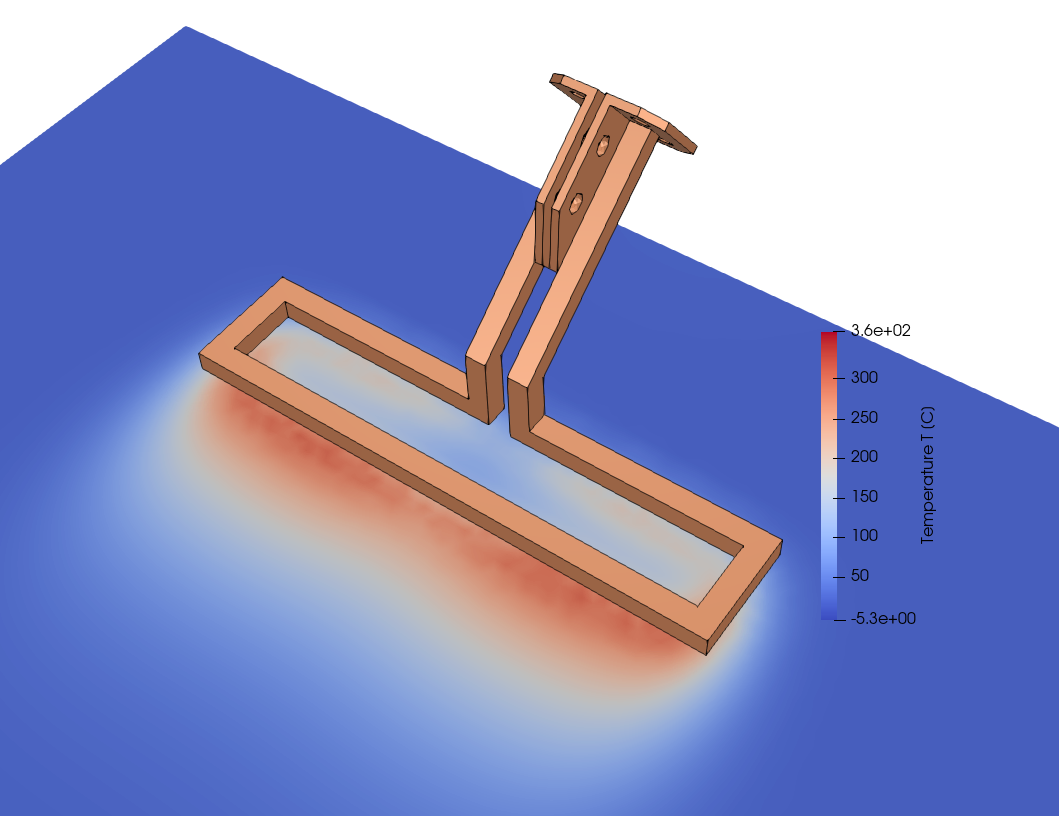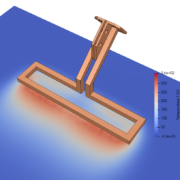Simulation of a moving inductor for coating removal systems
The attached simulation image demonstrates the thermal distribution of a moving inductor used in coating removal systems, providing detailed insights for engineers optimizing such processes.

Here’s a breakdown with specific details:
Inductor design and functionality
- The copper structure represents the inductor, which generates a high-frequency electromagnetic field to induce heat in the coating.
- In this case, the inductor is rectangular in shape and moves along the surface to ensure uniform heating.
Temperature distribution
- The color scale on the right provides temperature values in degrees Celsius (°C).
- Red zones indicate temperatures exceeding 360°C, which is ideal for softening or vaporizing the coating material.
- Blue zones show temperatures close to or below 0°C, representing areas outside the inductor’s immediate influence.
- The simulation clearly shows a thermal gradient, with maximum heating concentrated directly beneath the inductor, ensuring precise energy application.
Target surface and coating removal
- The blue surface beneath the inductor represents the coated substrate.
- At the shown power settings, the inductor creates a localized heating zone of approximately 20 mm width where the coating is removed effectively.
- The process ensures that only the coating is heated while the substrate remains within safe thermal limits, preventing any unwanted thermal damage.
Key parameters for engineers
- The simulation provides actionable data on the inductor’s movement and its impact:
- Inductor Speed: The inductor moves steadily across the surface at a rate optimized for uniform coating removal, typically in the range of 5–10 mm/s.
- Power Input: The power supplied to the inductor ensures sufficient heating to surpass the coating’s vaporization temperature (~300–350°C for most polymer or paint coatings).
- Frequency of Operation: The induction system likely operates at a frequency between 100–300 kHz, which is standard for heating thin coatings without overheating the base material.
Efficiency and practical implications
- By heating a defined zone, the moving inductor avoids wasting energy on uncoated regions. This ensures:
- Energy Efficiency: Focused heating minimizes overall energy consumption.
- Process Scalability: Suitable for larger surfaces by scaling the inductor’s size or optimizing its movement path.
- Precision: The simulation highlights how engineers can achieve millimeter-level control over the heating zone, crucial for removing coatings on sensitive materials.
This simulation is a valuable example of how tools like CENOS simulation software can help engineers fine-tune parameters to design efficient, precise, and cost-effective coating removal systems.


